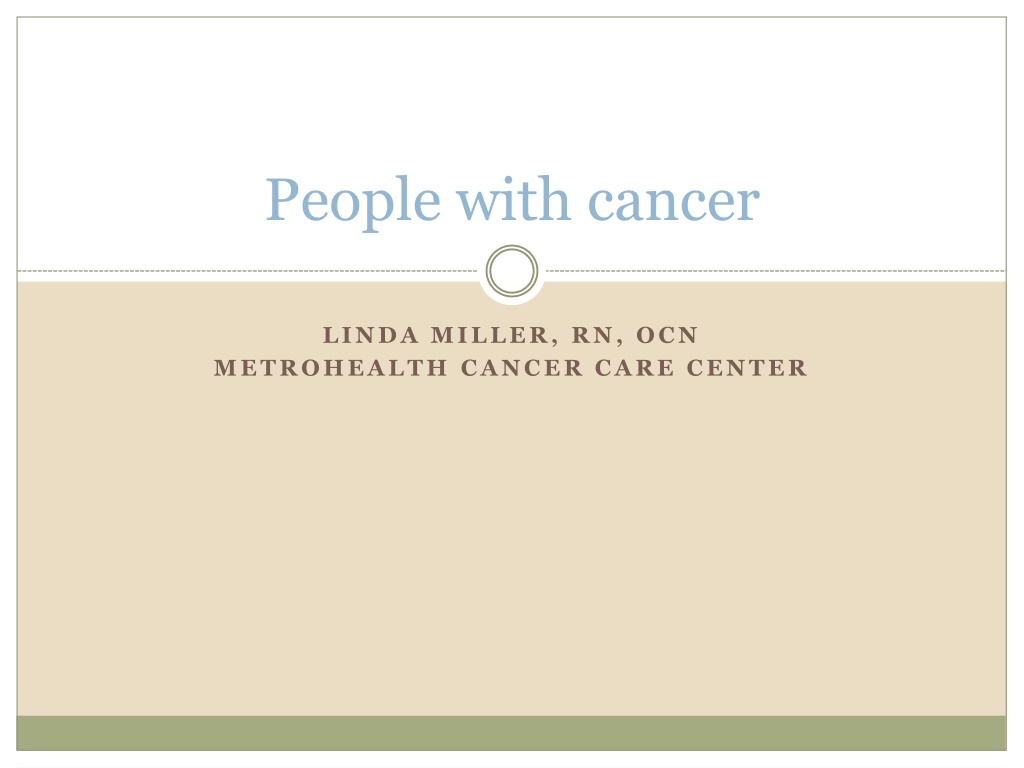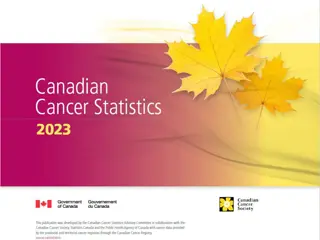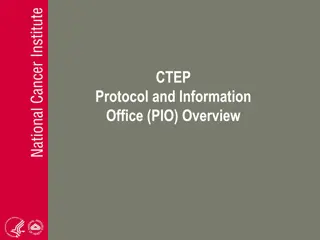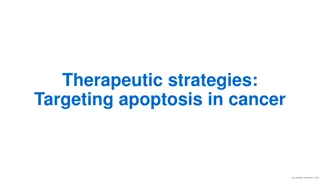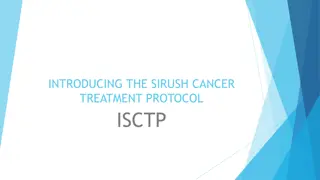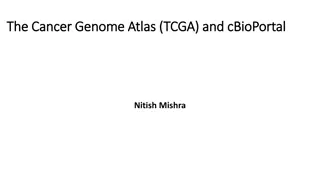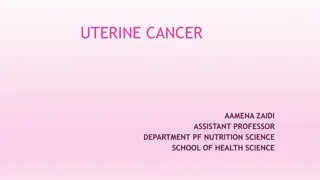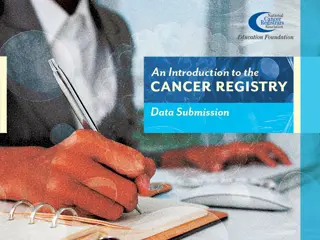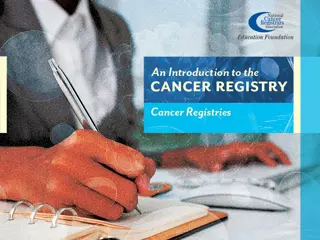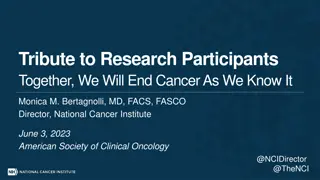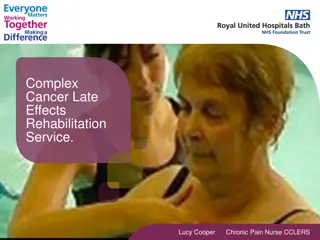Understanding Cancer Treatments and Side Effects
Explore the different modes of cancer treatment including surgery, radiation, and chemotherapy. Learn about the side effects of therapy such as fatigue, nausea, and skin issues. Discover how advancements like oral chemotherapy are changing the landscape of cancer care and the precautions needed to handle them effectively.
Download Presentation

Please find below an Image/Link to download the presentation.
The content on the website is provided AS IS for your information and personal use only. It may not be sold, licensed, or shared on other websites without obtaining consent from the author. Download presentation by click this link. If you encounter any issues during the download, it is possible that the publisher has removed the file from their server.
E N D
Presentation Transcript
People with cancer LINDA MILLER, RN, OCN METROHEALTH CANCER CARE CENTER
Statistics American Cancer Society estimates for 2014 In US 1,665,540 new cases In US 585,720 deaths In Ohio 67,000 new cases Cancer is the 2ndmost common cause of death in the US, responsible for 1 in 4 deaths
Statistics By 2030 expect 2.3 million new cases annually in US By 2030 cancer will be leading cause of death People living at least 5 years after cancer diagnosis 1970s 50% Currently 66%
Cancer treatments Modes of treatment Surgery Radiation Chemotherapy Treatment with single mode or multiple modes Example of multi-modal: Breast cancer (radiation to reduce tumor prior to surgery, chemotherapy after surgery)
Chemotherapy Usually given in outpatient setting Prevents cancer cells from metastasizing Systemic therapy Given intravenously Destroys good and bad cells Treatments on set schedule
Radiation therapy Local treatment directed at specific area Treatments scheduled daily, but treatment extends for weeks
Oral chemotherapy Increasing number of patients receiving oral chemotherapy PRECAUTIONS NEEDED: Handled with proper protection including chemo gloves Keep away from others in secure area
Side effects of therapy Fatigue Nausea/vomiting Diarrhea Fever Skin Pain Other
Side effects of cancer treatment Fatigue Most common side effect Due to decreased red blood cells leading to lower oxygen levels Inability to perform basic tasks No over-exertion, conserve energy Accommodations Frequent rest periods Nutritious foods, plenty liquids
Side effects of therapy Nausea Anti-nausea medications can prevent vomiting Nausea triggers Perfumes and odors Fried foods, spicy foods, fatty foods, overly sweet foods Dehydration Increased risk of nausea Women Younger patients Women with history of morning sickness
Helping people avoid nausea Provide small frequent meals (nausea occurs on an empty stomach) Avoid strong odors Assure availability of anti-nausea medication, encourage to take as prescribed Provide dry crackers/dry toast Avoid spicy, greasy, fatty foods
Helping people with diarrhea Imodium BRAT diet bananas, rice, applesauce, dry toast Avoid high fiber, high fat, greasy, spicy foods Avoid caffeine, milk, alcohol Increase fluids
People with fever Due to low blood counts, usually 7 to 10 days after chemo Observe for temperature increase First sign of infection If fever of 100.4 F or 38 C (have thermometer available) To ER or call oncologist on duty
Infection precautions Chemotherapy patients can reside in general population shelter, but away from ill people Dependent on instructions from physician Provide isolation if necessary
Skin problems Especially for people receiving radiation therapy Redness of skin Provide Eucerin, Aquaphor
People with pain Treat with medication Opioids Keep in secure place!
Other side effects Less frequent side effects related to attack on the good cells Alopecia May use head covering, even at night Numbness in fingers Difficulty feeling, holding things Stomatitis
Questions to ask If a shelter resident identifies as a person being treated for cancer, ask about Pain medicine Anti-nausea medicine Oral chemotherapy Personal supplies: ostomy bags, etc. Time and place of next treatment
Have available Rest area Nutritious foods Fluids (water, juice, Gatorade, popsicles, Jell-O) Imodium Thermometer
End of life concerns Understanding prognosis patients continue to "hope" - requesting more treatments Ask person (and listen to the answers) what care or treatment will be needed in the shelter and how best to provide the care Ask if caregiver is with person Ask about others providing care Ask about advanced directives
End of life concerns symptom control Pain adequate pain control Secretions control and/or managing secretions Constipation adequate hydration, stool softeners Anxiety medication, comforting environment, caregivers Dyspnea (difficulty breathing) positioning, oxygen
POD related information Per CDC no live vaccines Herpes Zoster (shingles) Flu mist (nasal spray) Measles, mumps and rubella (MMR) Smallpox Yellow fever Chicken pox
Thank you Questions? Comments?
